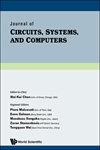Designs of High-Speed Triple-Node-Upset Hardened Latch Based on Dual-Modular-Redundancy
IF 1
4区 工程技术
Q4 COMPUTER SCIENCE, HARDWARE & ARCHITECTURE
引用次数: 0
Abstract
The development of modern process CMOS integrated circuits has reduced the feature sizes and thus the reliability of the chip continuously. First, this paper proposed two kinds of single-node upset self-recovery feedback loops with low overhead. One is called P-RFL which is composed of P-type complementary element (CP) and Clocked CP (C 2 P), and the other is called N-RFL which is composed of N-type complementary element (CN) and Clocked CN (C 2 N). Second, in order to fully tolerate triple-node upsets (TNUs), this paper presents three TNU-hardened latches: C 2 P-C 2 N, DMR-C 2 P and DMR-C 2 N. Using the blocking ability of the C-element, the outputs of two RFLs are connected to the C-element array. Therefore, when any three nodes upset at the same time, the transient pulse propagates inside the latch step by step, and disappears after being blocked by the C-element, ensuring that the TNU-hardened latches can restore to the correct logic state. HSPICE simulations show that all the three proposed latches achieve lower power, delay and APDP, compared with other six TNU-hardened latches. DMR-C 2 N achieves the lowest power, delay and APDP. In addition, the PVT variations analysis show that three proposed TNU-hardened latches are less sensitive to the variations of process, voltage and temperature.基于双模冗余的高速三节点加厚锁存器设计
现代工艺CMOS集成电路的发展使其特征尺寸不断减小,从而使芯片的可靠性不断提高。首先,提出了两种低开销的单节点扰动自恢复反馈回路。一个叫P-RFL由P型互补元素(CP)和以CP (C 2 P),另一个是叫做N-RFL由N型互补元素(CN)和以CN (C 2 N)。第二,为了充分容忍triple-node不适(TNUs),本文提出三个TNU-hardened门闩:C 2 pci 2 N, DMR-C 2 P和DMR-C 2 N .使用的屏蔽能力C-element两个采用树脂的输出连接到C-element数组。因此,当任意三个节点同时被打乱时,瞬态脉冲在锁存器内部逐级传播,被c元件阻挡后消失,保证了经过tnu加固的锁存器能够恢复到正确的逻辑状态。HSPICE仿真结果表明,与其他六种tnu硬化锁存器相比,这三种锁存器都具有更低的功耗、延迟和APDP。dmr - c2n实现了最低的功耗、时延和APDP。此外,PVT变化分析表明,三种强化锁存器对工艺、电压和温度变化的敏感性较低。
本文章由计算机程序翻译,如有差异,请以英文原文为准。
求助全文
约1分钟内获得全文
求助全文
来源期刊

Journal of Circuits Systems and Computers
工程技术-工程:电子与电气
CiteScore
2.80
自引率
26.70%
发文量
350
审稿时长
5.4 months
期刊介绍:
Journal of Circuits, Systems, and Computers covers a wide scope, ranging from mathematical foundations to practical engineering design in the general areas of circuits, systems, and computers with focus on their circuit aspects. Although primary emphasis will be on research papers, survey, expository and tutorial papers are also welcome. The journal consists of two sections:
Papers - Contributions in this section may be of a research or tutorial nature. Research papers must be original and must not duplicate descriptions or derivations available elsewhere. The author should limit paper length whenever this can be done without impairing quality.
Letters - This section provides a vehicle for speedy publication of new results and information of current interest in circuits, systems, and computers. Focus will be directed to practical design- and applications-oriented contributions, but publication in this section will not be restricted to this material. These letters are to concentrate on reporting the results obtained, their significance and the conclusions, while including only the minimum of supporting details required to understand the contribution. Publication of a manuscript in this manner does not preclude a later publication with a fully developed version.
 求助内容:
求助内容: 应助结果提醒方式:
应助结果提醒方式:


